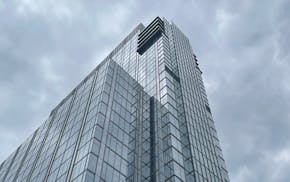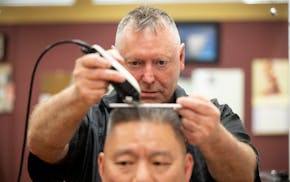Award-winning industrial designer Bob Worrell of Minneapolis has created memorable products over the past 40 years.
They include the Bobcat Co. logo that adorns two generations of the front loader. And the "smart straw" attached to cans of WD-40 that doesn't fall off when flipped from stream to spray mode.
Yet Worrell, 67, admits he's not a great business manager. He could never budge his company, Worrell Design Inc., above $2 million in revenue, even after a move in 2000 to leased space in Eden Prairie's then-dubbed "Technology Prairie."
That proved just in time for the 2001-02 technology recession, and a revenue swoon. And it got Worrell thinking about leadership.
"I had a business vision, but I was unfocused," Worrell conceded. "I'm a designer."
So, he turned to his son Kai Worrell, who by 2002 had built a successful landscaping and snow-removal company, to lead the business.
"Bob gave me a salary of about $50,000 and I was making as much or more at the landscaping business," Kai Worrell said. "But that started in college, and I didn't want to do it forever. I didn't really get the design business at first. I started to understand it and see a future."
Kai Worrell, 36, who studied accounting at the University of Minnesota, took over business operations. Bob Worrell and a small design team focused on a stable group of medical product and consumer clients that started to grow as the economy recovered in 2003-04.
Return to Minneapolis
In 2005, Kai Worrell moved Worrell Design from 6,000 square feet of "sterile" space in the Eden Prairie office park and headed back to northeast Minneapolis. The family-owned company bought a 30,000-square-foot building in 2005 near the refurbished Grain Belt Brewery on the Mississippi River. Northeast is a reviving commercial center that boasts technology and marketing firms, professional services, microbreweries and restaurants operating from refurbished spaces in formerly shuttered warehouses, factories and vacant storefronts.
The Worrell family could not have afforded the discounted $2.1 million price were it not for a motivated seller who even helped finance the down payment.
"Worrell had been renting space for 25 years, and I really wanted to get into an urban, creative area," Kai Worrell said. "And we couldn't afford Uptown or the Warehouse District. "Northeast was cheaper, and this building was so unique. There was plenty of parking. And our business plan was starting to work."
The Worrell building, once occupied by a maker of concert and movie sets, has been gradually converted into a 40-person "innovation center" for designers and engineers, including an event space and a rooftop patio with a stunning view of the river and downtown. Kasey Worrell Hatzung, Bob Worrell's daughter, runs Fusion Hill, an independent 25-person brand-strategy and Web design business in the other third of the building.
As Worrell Design has grown since 2005, Kai Worrell has invested about $1 million to gradually renovate the space.
"It was a dingy warehouse that we built into a glass-and-steel structure inside, kind of like a metal treehouse with a bridge [on the second level] with open spaces, including living rooms and conference rooms, a kitchen … and there's still some open space," Kai Worrell said.
Medical products market
Eighty percent of Worrell's business is designing medical products for Medtronic, Johnson & Johnson, Boston Scientific and other medical-device makers. Worrell has designed 35 medical devices approved by the U.S. Food and Drug Administration (FDA) — from dental and diabetes management tools to infusion systems, monitors, heart valves, cardiac pacemakers and defibrillators. Another 45 products are in the regulatory pipeline today.
In 2007, Kai Worrell opened what it is now a 15-person office in Shanghai to serve China and other emerging markets with proven but lower-cost medical instruments that are made in Asia.
"If we were going to grow, we had to leapfrog to China … and we were working with a client that made it advantageous to be there," he said. "We take existing technologies, localize and design them appropriately for the local countries."
'A firm with horsepower'
Kai Worrell was named CEO in 2009, and the business has taken off. Worrell, which had revenue of $4 million in 2007, projects $8 million in revenue this year and $10 million in 2015.
"Clients from whom we were seeking projects worth $100,000 to $1 million are walking in … and they see diverse teams with diverse talents working in a cool space and doing quality work for less than what it costs on the East or West Coasts," Kai Worrell said. "They see a firm with horsepower."
He optimistically projects the 55-employee company will hit revenue of $15 million and add another 40 jobs over the next five years. And the risk-oriented CEO has placed a wager on that growth through the $600,000 purchase earlier this year of 3-D imaging equipment and software made by Stratasys of Eden Prairie.
It allows Worrell Design to produce plastic prototype molds of medical devices and trial parts for testing and regulatory review that can be made and quickly modified. That can save weeks and tens of thousands of dollars for manufacturers.
"We looked at five [design] companies, and Worrell wasn't the cheapest but they were the most value for the money," said Weaver Gaines, CEO of Florida-based OBMedical, which has licensed technology from University of Florida and is using Worrell to design and produce plastic prototypes of the LaborView sensor system for pregnant women that is under FDA review.
"Worrell has the mechanical and electrical engineers and designers on staff, and they've got the rapid-prototyping system that allows you to see what the product will look like," Gaines said. "They use that plastic mold to make actual devices."
That's also a big initial savings, he added. Only when a product is approved and ready for mass production does the manufacturer need to invest in expensive metal molds. In the meantime, the plastic prototype molds can easily be tweaked.
"They used an X-Acto knife to scrape away a little more room for a battery," Gaines added. "We didn't have to spend $20,000 or more for a new aluminum mold. And you can make enough prototypes from the plastic molds to test them and get the pilot product through testing and FDA approval. You don't want to go to aluminum [or steel] mold until you've got the product approved and ready for mass production."
Neal St. Anthony • 612-673-7144
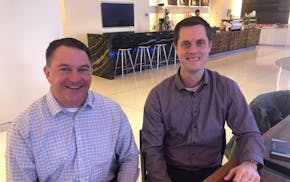
St. Anthony: 'Patient' investing paying off for St. Paul's Hill Capital
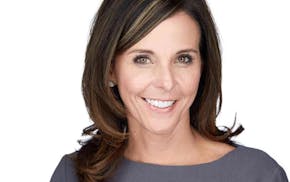
Jennifer Smith, leader of Burnsville's Innovative Office Solutions, has died
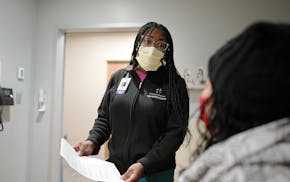
St. Anthony: Medical professions in Minnesota need more people of color in their ranks
